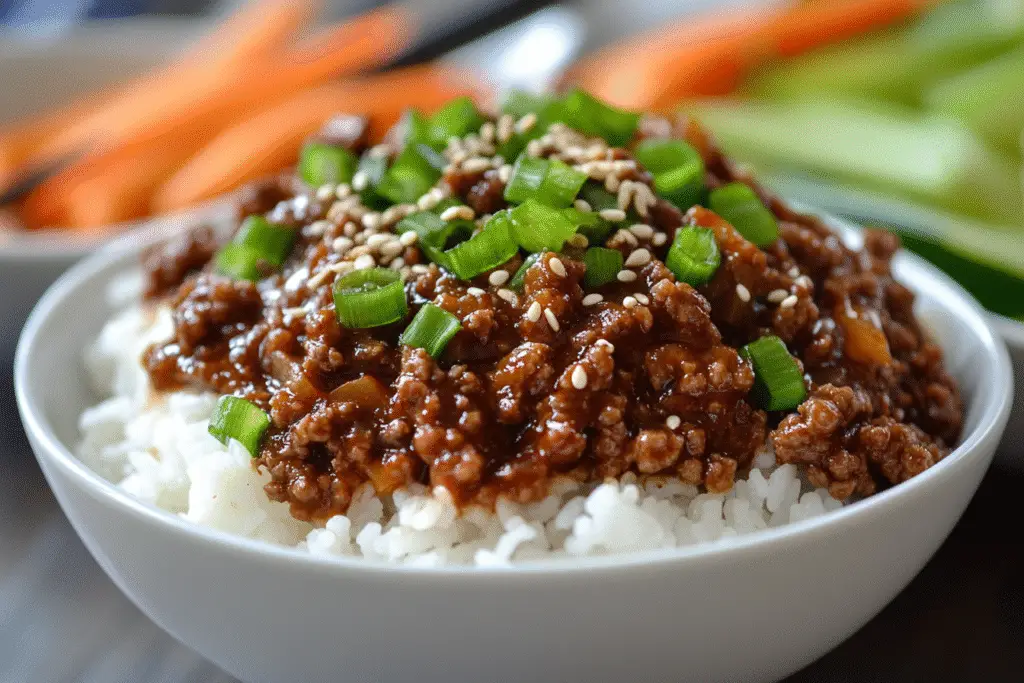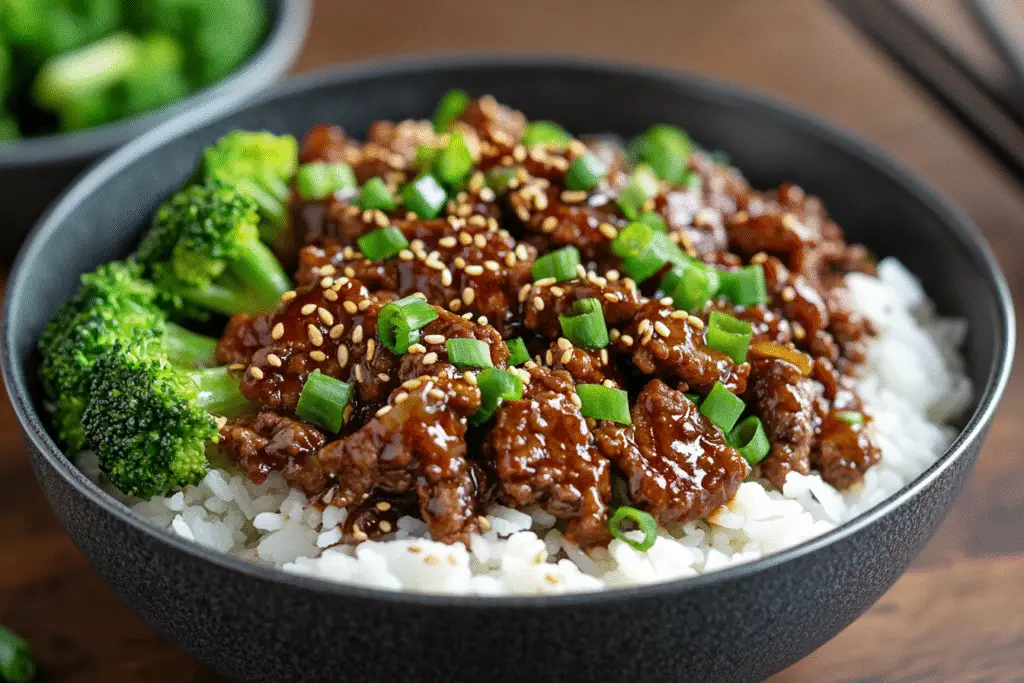Korean beef, often called Korean Ground Beef Bowls or simply Korean Beef, is a fast, versatile, and deeply satisfying dish that captures the sweet, savory, and slightly spicy flavors of traditional Korean cuisine—without the lengthy marinade times or grilling required for more complex recipes like bulgogi.
This dish has become a weeknight favorite for many home cooks because it’s quick to make, uses pantry-friendly ingredients, and is highly adaptable. Whether you’re using ground beef or thinly sliced steak, Korean beef is a perfect entry point into Korean-inspired flavors and an excellent meal prep option.
Let’s explore everything you need to know to make the perfect Korean beef, including cooking techniques, ingredient tips, common mistakes, flavor variations, and storage guidelines.
Why Korean Beef Is the Perfect Quick Dinner
Traditional Korean beef dishes like bulgogi and galbi require marinating beef for several hours and cooking over high heat to get that classic grilled flavor. While incredibly delicious, these methods can feel time-consuming for busy weeknights.
Korean beef offers a shortcut version that still delivers those signature flavors:
- Sweetness from brown sugar.
- Salty depth from soy sauce.
- A hint of sesame oil and garlic.
- Optional heat from gochujang or red pepper flakes.

Common Mistakes and How to Avoid Them
- Beef is dry: Ground beef can overcook quickly. Avoid high heat once browning is complete.
- Sauce is too salty: Balance soy sauce with sugar and don’t over-reduce.
- Beef lacks flavor: You need to simmer the sauce with the beef so it fully absorbs the seasonings.
Choosing the Right Ingredients
Beef Selection
- Ground Beef (80/20 or leaner): Fast-cooking and perfect for bowls.
- Thinly Sliced Flank or Sirloin Steak: More like a homemade bulgogi stir-fry.
- Avoid fatty cuts or high-fat ground beef that can make the sauce greasy.
Key Sauce Ingredients
- Soy Sauce: The base of the sauce. Low-sodium is a good option.
- Brown Sugar: Essential for that signature sweet-savory balance.
- Garlic and Ginger: Build aromatic depth.
- Sesame Oil: Adds nuttiness and authentic Korean flavor.
- Red Pepper Flakes or Gochujang: Adds optional heat.
Optional Add-Ins
- Green Onions
- Toasted Sesame Seeds
- Steamed Vegetables: Broccoli, carrots, or bok choy

Essential Equipment
- Large skillet or sauté pan: Wide enough to brown ground beef without crowding.
- Wooden spoon or spatula: For breaking apart and stirring ground beef.
- Small mixing bowl: For making the sauce.
Korean beef is extremely low-maintenance when it comes to equipment—perfect for quick meals with minimal cleanup.
Smart Prep Strategies
One of the best things about Korean beef is how quickly it comes together. Here’s how to make it even faster:
- Pre-mix the sauce: Have it ready before you start browning the beef.
- Make extra sauce: Store it in the fridge for up to a week to quickly make additional batches.
- Prep garnishes: Chop green onions and toast sesame seeds in advance for quick assembly.
If you’re using thinly sliced steak instead of ground beef, slice it before starting to ensure a smooth cooking process.
Flavor Variations and Customizations
Make It Spicier:
- Add gochujang (Korean chili paste) for authentic heat.
- Use more crushed red pepper flakes.
- Drizzle with sriracha or chili oil.
Make It Sweeter:
- Increase brown sugar slightly or add a dash of honey.
Swap Proteins:
- Use ground turkey, ground chicken, or thinly sliced pork instead of beef.
Add Vegetables:
- Stir-fry broccoli, snow peas, or spinach directly into the beef.
- Serve over a bed of shredded lettuce for a low-carb option.
Common Mistakes and How to Fix Them
- Beef is dry: Ground beef should be browned but not overcooked. Simmer in the sauce just until it’s heated through.
- Sauce is too runny: Simmer the sauce with the beef for a few extra minutes to let it thicken slightly.
- Beef is bland: Ensure the sauce coats the beef fully and taste-test before serving. Don’t skimp on garlic and ginger.
Storage, Freezing, and Reheating Tips
- Storage: Store in an airtight container in the fridge for up to 4 days.
- Freezing: Korean beef freezes beautifully. Cool completely, store in freezer bags or containers, and freeze for up to 3 months.
- Reheating: Warm gently in a skillet over medium heat, or microwave in short intervals, stirring in between.
Korean Beef Recipe
Ingredients
For the Beef:
- 1 pound ground beef (80/20 or leaner)
- 1 tablespoon sesame oil
- 3 cloves garlic, minced
- 1 teaspoon fresh ginger, minced (optional)
For the Sauce:
- ¼ cup soy sauce (low-sodium recommended)
- 3 tablespoons brown sugar
- ½ teaspoon crushed red pepper flakes (optional)
- 1 tablespoon gochujang (optional, for heat and depth)
- 1 tablespoon rice vinegar (optional, for brightness)
For Garnish:
- 2 green onions, sliced
- 1 tablespoon toasted sesame seeds
- Cooked white rice, for serving
Step-by-Step Instructions
Step 1: Brown the Beef
- Heat sesame oil in a large skillet over medium heat.
- Add ground beef and cook, breaking it apart with a wooden spoon, until browned and cooked through, about 5-7 minutes.
- Drain excess fat if necessary.
Step 2: Add Aromatics
- Stir in minced garlic and ginger.
- Cook for 1-2 minutes until fragrant.
Step 3: Make the Sauce
- In a small bowl, whisk together soy sauce, brown sugar, red pepper flakes, gochujang (if using), and rice vinegar.
- Pour sauce over the cooked beef.
Step 4: Simmer the Beef
- Stir well to coat all the beef in the sauce.
- Simmer for 2-3 minutes until the sauce thickens slightly and clings to the beef.
Step 5: Assemble and Serve
- Serve the Korean beef over steamed white rice.
- Garnish with green onions and toasted sesame seeds.
- Optionally, add steamed broccoli, shredded carrots, or bok choy for extra vegetables.
Serving Suggestions
- Traditional: Over white rice, with kimchi on the side.
- Low-carb: Serve in lettuce wraps or over cauliflower rice.
- Meal prep: Divide into containers with rice and vegetables for easy grab-and-go lunches.
- Bowls: Pair with pickled cucumbers, sautéed spinach, and a fried egg for a Korean-inspired rice bowl.
Korean Beef Variations: Ground Beef vs. Sliced Steak vs. Vegetarian
| Feature | Ground Beef Version | Sliced Steak Version | Vegetarian Version |
|---|---|---|---|
| Protein | Ground beef | Flank or sirloin steak | Tofu, tempeh, mushrooms |
| Cook Time | ~15-20 min | ~20-25 min | ~15-20 min |
| Sauce Style | Simmered with beef | Stir-fried separately | Same |
| Texture | Crumbly, saucy | Tender slices | Chewy or hearty |
FAQs and Troubleshooting
Can I make Korean beef without gochujang?
Yes. Gochujang adds heat and depth, but the dish is still delicious without it.
Can I make this gluten-free?
Use gluten-free soy sauce or tamari. Gochujang can also contain gluten, so check labels or use a gluten-free chili paste alternative.
Why is my beef dry?
Be careful not to overcook. The sauce should simmer briefly to coat the beef but not dry it out.
Can I freeze Korean beef?
Yes. It freezes and reheats very well.
How can I add more vegetables?
Toss in steamed broccoli, sautéed mushrooms, or snow peas when adding the sauce.
Final Thoughts
Korean beef is a quick, satisfying, and flavor-packed meal that’s perfect for busy weeknights but delicious enough to make anytime you’re craving bold flavors. With its sweet, savory, and slightly spicy profile, it’s endlessly customizable and a fantastic introduction to Korean-inspired cooking.
Whether you’re serving it over rice, packing it into lettuce wraps, or meal-prepping for the week, this easy Korean beef recipe is sure to become a regular in your dinner rotation. It’s proof that you don’t need a lot of time or complicated ingredients to bring exciting global flavors to your home kitchen.
